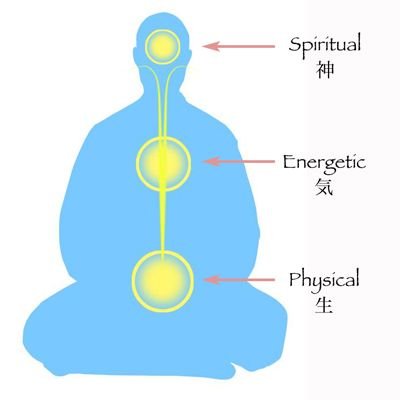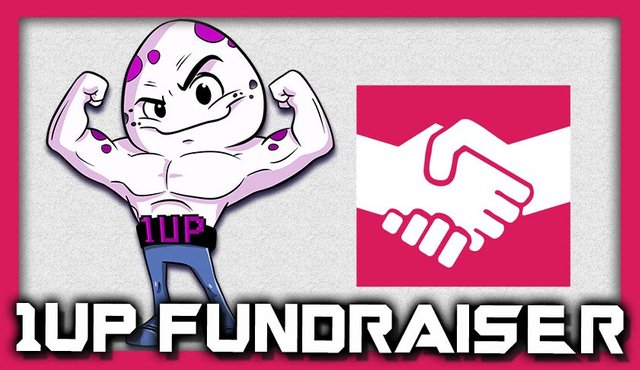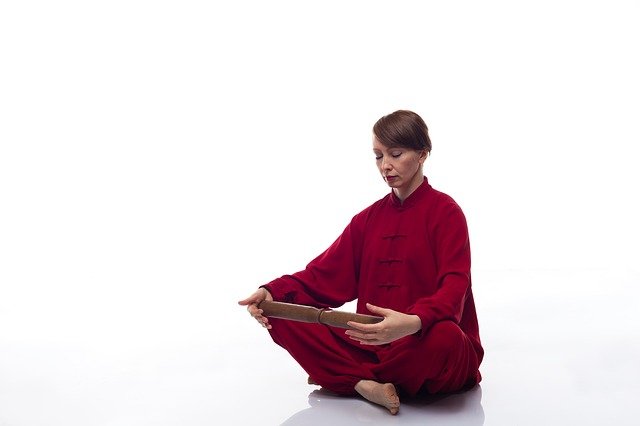☯️ The Silence That Stirs The Wind
An introduction to Tai Chi & Qigong
I've been practicing Tai Chi & Qigong for 20 years now, and have spent the last four years teaching it. A couple of years ago, I developed a form that combined elements of Taoist alchemy, mindful exercise, and Tantric Yoga. This is a brief introduction to these wonderful and mysterious practices, and is a contribution to the Esoteric Content Contest (1UP Fundraiser)
Meditation & medication in movement
The first written references to the Chinese martial arts therapeutic calisthenics date back over 2000 years, as a dance designed to ward off disease and regulate breathing as a preventative health therapy.
Since these early time, it has continued to develop and diverge as an important aspect of both Chinese Medicine and Taoist practices, with different branches and schools evolving over time. All have their basis in the idea that immortality and longevity come from cultivating one’s own physiological and psychological states using mindful exercise.
The various practices and forms have over the years been influenced by the ‘three treasures’ of Chinese philosophy: Taoism, Confucianism, and Buddhism. These ideas were particularly developed by Taoist and Buddhist monks, and became fused with the martial arts, considered important in ancient times as hand-to-hand combat was the norm in times of war.
Tai Chi Chuan was developed by the Warrior-Monks of the Shaolin Temple, where the offensive and defensive movements were given philosophical notions. It is credited by being developed during the late 13th Century by Chang Sanfeng. The story goes that he was inspired by witnessing a battle between a snake and a crane to create a soft flowing, meditative style of martial art. He realised the superior power of the soft over the hard, the tactical wisdom of circular movements, and the importance of moving in response to, as well as in anticipation, of your opponent’s tactics.
It is probably the single-most popular and famous style of Qigong, involving slow, rhythmic movements, shifting weight from foot to foot, with one posture transforming effortlessly and minimally into the next. It has become a practice to calm the 'monkey mind', centre one's thoughts, and ground one's body.
Qigong as it is known today was developed through the Taoist 内丹 nèidān (alchemy) tradition, where the ideas of health preservation and longevity were fused with the metaphysical ideas around nature, and the micro/macrocosmic inter-relationships between humans and their environment. In this tradition, there was both 'inner' and 'outer' styles (common amongst Taoist practices, including medicine).
内工 Nèigōng (‘internal mastery’) is the act of developing one's internal nature and energies for higher spiritual purposes; while 外工 Wàigōng (‘outer mastery’) is the practice of developing the physical body. This dichotomy is more-or-less illusory, as even during the earlier centuries it was understood that internal development led to physical development, and vice versa.
There are many types of forms: moving forms, and stillness forms; forms for stretching the sinews; and forms for building strength and flexibility. The one thing that binds all forms is the principle that your breath is vital for physiology, which in turn will improve your psycho-emotional state, which in turn increases personal performance.
How does it work?
Qigong practice is known to switch our nervous system from stress-related sympathetic ‘fight-or-flight’ mode into the restorative healing mode of the parasympathetic, what happens when we are properly resting or sleeping.
Its effects on the immune system have been shown to increase T-cell production, and by inhibiting secretion of adrenaline and cortisol it also prevents these hormones from damaging the immune system. Qigong’s ability to greatly improve blood circulation and relieve cardiac illness as well as improving respiratory function and lung capacity are well known. All these have an influence of the effectiveness and health of the digestive system, and helps regulate and maintain a good pH balance.
三寶虛 Sānbǎoxū — The guiding principles of the 3 treasures

In Nèigōng schools, humans have 3 bodies: the physical body, the energetic body, and the spirit body. These three bodies are linked to each other and the rest of the world via the three 丹田 Dāntián, generally referred to as lower, middle, and upper.
Vitality
The physical body is regulated through the Lower Dāntián, located below and behind the umbilicus, and governed by your 精 Jīng — Vital Essence. Here, your Being is in its most yin form: dense, material and solid. It is healed through the introduction of nutrients — the biochemical building blocks, derived from your food & drink, and medicines (herbal or pharmaceutical) you consume. Most fitness exercises are aimed at enhancing and making changes to physical tissue. This is also the focus of Wàigōng practices and martial arts training.
Energy
When the Lower Dāntián is activated, a gateway to the energetic body is opened. The energetic body is where the 氣 Qì dwells — this is the realm of channel systems and where acupuncture works. There is no altering biochemistry here, but there is the regulation and movement of Qì around the body.
Breathwork is important here, as Qì is said to follow the breath. When the Lower Dāntián is open, then Jīng can be converted into Qì to help the energy body. Conversely Qi can be converted into Jīng to aid the physical body. This is why combining acupuncture treatment with either food therapy or herbal medicine is essential, in that you effect change in both bodies to bring about good health and harmony.
Interestingly, what in Yoga is referred to as the ‘emotional body’ is part of this energetic body in Qigong theory. In this tradition, emotions are seen merely as an expression of Qì is moving (or not) within us. However, they are more complex as our conditioning attaches certain thought-forms and values to the sensations created as Qì flows through us. The Middle Dāntián, located in the centre of the chest, analogous with the physiological heart, is the interface between the Qì of the energetic body, and our consciousness.
Spirit
The spirit body is equated to consciousness, 神 Shén. Your consciousness governs who you are as an individual; it determines how you think, act, and behave. Connected to the outer world via the Upper Dāntián in the centre of your brow, your Shén filters your experiences and interactions with the world.
Your Mind/consciousness experiences your inner world via the Middle Dāntián. Through this interface, your Qì can be transformed into the energy that consciousness requires to experience your inner world; and in turn your Shén can be directed towards your Qì to alter your physiology and energetic/emotional states as intentionality.
Health benefits
As a type of Qigong practice, your centre of balance is always in your Lower Dāntián. There has been a lot of research into Tai Chi as a practice for healing and disease prevention. So far, it has been shown to improve your health in the following common areas:
- Muscle strength
- Flexibility
- Balance
- Aerobic conditioning
- Quality of life
Those with the following conditions may find significant benefits from undertaking a Tai Chi practice:
- Osteo-arthritis
- Rheumatoid arthritis
- Low bone density
- Breast cancer
- Heart disease
- Heart failure
- Hypertension
- Parkinson's Disease
- Sleep problems
- Stroke
- Stress
- Immune system deficiency
- HIV/AIDS
- Metabolic Syndrome
- Diabetes
- Headaches
- Fibromyalgia
- Depression
- Anxiety
- Cholesterol levels
Here are several links to research into the benefits of these practices:
A comprehensive review into of health benefits of qigong and tai chi
A randomised trial of tai chi for fibromyalgia
Tai chi exercise in patients with chronic heart failure
Comparative effectiveness of Tai Chi versus Physical Therapy for knee Osteoarthritis
A systematic review and meta-analysis of the effects of Qi Gong and Tai Chi for depressive symptoms
Qigong for the primary prevention of cardiovascular disease
Qigong for hypertension: a systematic review
Health benefits of qigong or tai chi for cancer patients: a systematic review and met-analyses
MADE FOR STEEMIT


 |  |
|---|
This is a special #esoteric bounty post for 1UP, the Curation System for Communities. Check out the fundraiser to learn more about its function and the latest airdrops:
https://fundition.io/#!/@steem-1up/0xxjea70g.



What a lovely post and with so much excellent information. I am sure that after 20 years of practice, you are really enjoying all the benefits from this.
I'm going to read this post again to absorb it properly. You write so simply and clearly and I'm fascinated by this field as it's not something I've been able to really explore in detail. Thanks so much for writing on it!
I would love to see this form you have that is a little bit alchemy a little bit tantra 😊 it sounds fascinating and right up my alley!
Great post. Makes me want to get my sword out and play in the backyard for a bit. 😊
I immediately thought of you as I read this post and really wanted to tag you, but you already found it! Love your work!
I’m currently training in Wu Xing Dao (Yang Mian) that combines different forms of internal arts including Tai Chi. We do have some Qigong sessions too.
That’s awesome man, would love to hear more about it.
It’s hard to describe. I’m in first year and only doing the Mian Quan style. We do punches like if the fist is attached to the shoulder with a chain (arm and forearm) and use the body to then throw the fist like a flail. Our warm up session is standing static and spinning our arm for 5 minutes each side followed by energy generation by compressing the air inside or lung.
Posted using Partiko iOS
Hi @metametheus!
Your post was upvoted by @steem-ua, new Steem dApp, using UserAuthority for algorithmic post curation!
Your UA account score is currently 3.225 which ranks you at #8005 across all Steem accounts.
Your rank has improved 125 places in the last three days (old rank 8130).
In our last Algorithmic Curation Round, consisting of 407 contributions, your post is ranked at #174.
Evaluation of your UA score:
Feel free to join our @steem-ua Discord server
Congratulations! This post has been upvoted from the communal account, @minnowsupport, by 📀 Petah Raven [metametheus] from the Minnow Support Project. It's a witness project run by aggroed, ausbitbank, teamsteem, someguy123, neoxian, followbtcnews, and netuoso. The goal is to help Steemit grow by supporting Minnows. Please find us at the Peace, Abundance, and Liberty Network (PALnet) Discord Channel. It's a completely public and open space to all members of the Steemit community who voluntarily choose to be there.
If you would like to delegate to the Minnow Support Project you can do so by clicking on the following links: 50SP, 100SP, 250SP, 500SP, 1000SP, 5000SP.
Be sure to leave at least 50SP undelegated on your account.
This is so good @metametheus, I mean juicy delicious good to my spirit and soul. I wish I could have caught it before it cycled out along with your article on the elements. This post and the elements need a reboot. All you have to do is change things around and it could be a 2.0 version(lol). I do have an idea....because so many that have made a choice to live on the natural & spiritual side of life need this information. I will be in touch soon. @metametheus.